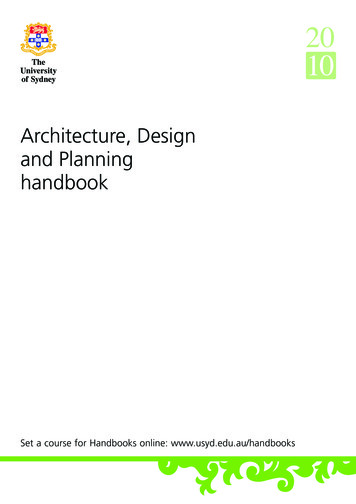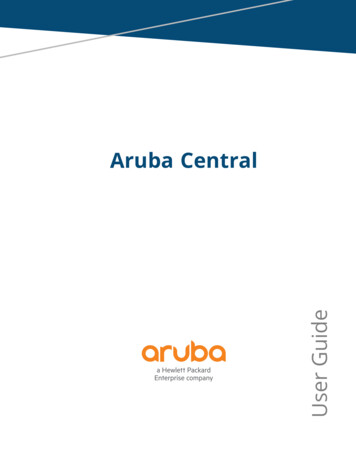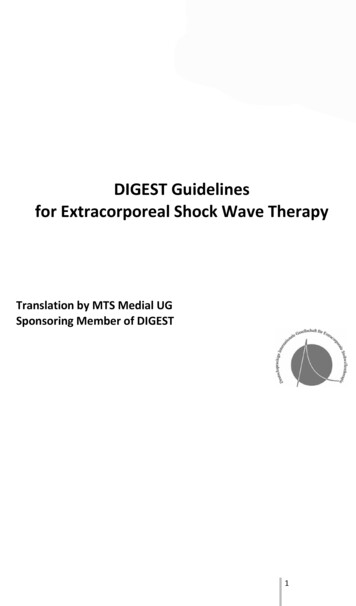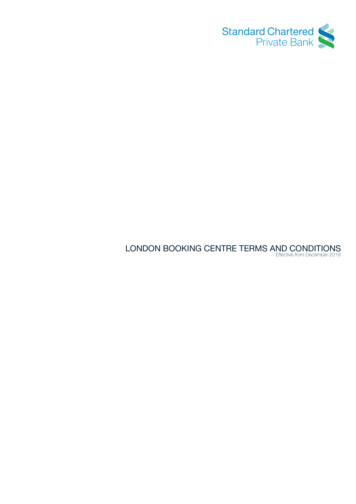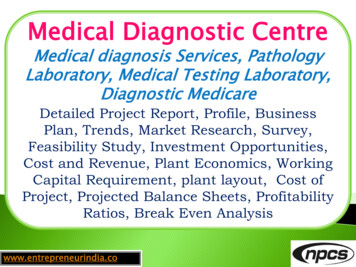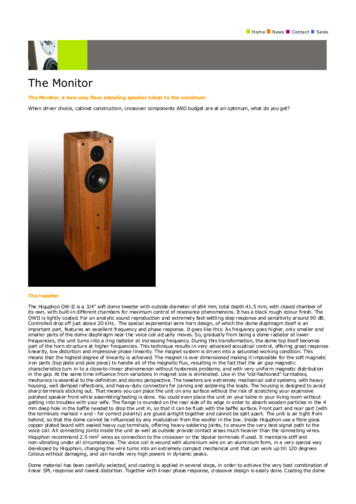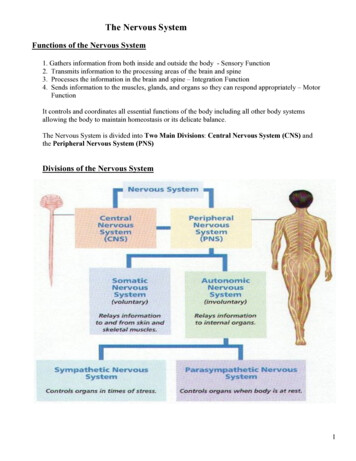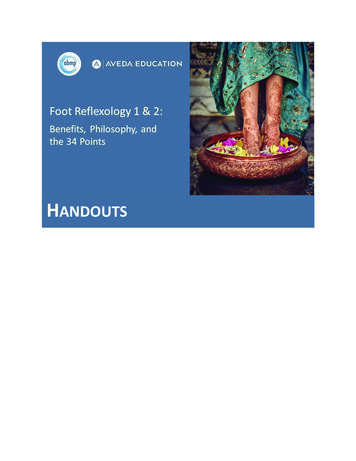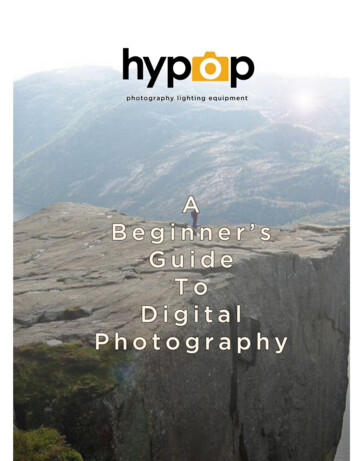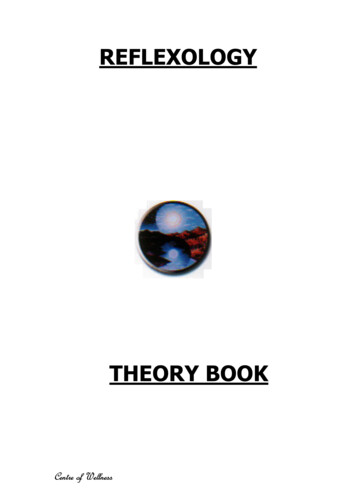
Transcription
REFLEXOLOGYTHEORY BOOKCentre of Wellness
WHAT IS REFLEXOLOGY?Reflexology is the practice of applying pressure to points on the feet andhands, usually the feet, to stimulate the body’s own healing system. Thename ‘reflexology’ may come from the fact that reflexologists believe parts ofthe body are reflected on the feet and hands, or it may come from theconcept of a reflex action. A reflex action occurs in a muscle or organ when itis activated by energy from a point of stimulus on the body. In reflexologythe point of stimulus is on the hand or foot.Reflexologists believe that applying pressure to these reflex points canimprove physical and mental health. Depending on the points chosen,therapists can use the modality to ease tension, reduce inflammation,improve circulation and eliminate body toxins. Reflexology is a safe, effectiveform of treatment, which practitioners use to stimulate the body to heal itself.They do this by working on the physical body to encourage healing at thephysical, mental and emotional levels. And, although the therapy involves noconscious effort on the patient’s part, it encourages the body’s healing systemto search for its point of balance or ‘homeostasis’.How does it work?No one knows exactly how reflexology works beyond the physical act ofstimulating nerve endings in the foot.In a healthy body the brain is constantly sending out and receiving messagesalong the pathways of the nervous system. Good communication isnecessary for good health. But sometimes the pathways get blocked andmessages cannot get through. Reflexology may be able to operate bystimulating the autonomic reflex system to clear blockages, so that thecommunication lines stay open and the body, mind and emotions stayhealthy.We know that there are over 70,000 nerve endings on the sole of each footwhich, when stimulated, can send messages along the pathways of theautonomic nervous system to all areas of the body and brain. Pressureapplied to nerve endings can influence the body systems, including thecirculation and lymphatic system.Improvements in circulation and the lymphatic system result in improvedbody functioning because nutrients and oxygen are transported moreefficiently round the body and toxins are eliminated more easily. Throughthis physical reflex action, reflexology can stimulate the body’s energy toimprove general wellbeing and effectively clear out congestion. Reflexologistsaccess the energy through zones.Centre of Wellness
The body is divided into ten vertical zones or channels, five on the left andfive on the right. Each zone runs from the head right down to the reflexareas on the hands and feet and from the front through to the back of thebody. All body parts within any one zone are linked by the nerve pathwaysand are mirrored in the corresponding reflex zone of the hands and feet.By applying pressure to a particular point, known as a reflex point or area,the therapist can stimulate or rebalance the energy in the related zone. Forexample, the left kidney, which is in zone two of the left-hand side of thebody, is reflected at the same point in zone two of the left foot.If an energy blockage occurs on a zone, it can affect several body parts withinthat zone, causing more than one symptom of ill health. For example,someone with a problem in the left kidney can sometimes develop problemsin the left eye because the eyes and kidneys are both linked by the energy inzone two.The Feet as a Mirror of the Body:It is sometimes easier to envisage the reflex areas on the feet if you think ofhow the shape of the feet relates to the body’s shape.Reflexology, like auricular therapy is a form of holography, the belief thatsmall parts of the body can be used to treat the whole. The body is believedto be mirrored in the shape of feet, so that if you were lying down with yourfeet together, heels resting on the floor and toes pointed toward the ceiling,the shape of your feet would match the outline of your body. Think of it interms of a miniature body being superimposed on the soles of the feet, witheach foot reflecting half the body. The toes correspond to zones in the head and neck, covering the head,brain, eyes, nose and teeth. The soft fleshy balls of the feet reflect the lungs, chest and shoulders. The section from the ball of the feet to the middle of the arch coversthe area from the diaphragm to the waist. The area from the middle of the arch to the start of the heel relates tothe waist and pelvic area. The heels themselves relate to the left and right pelvic area and thesciatic nerve. The inside curve of each foot mirrors the curves of the spine. The outsides of the feet, starting from the top and working down,relate to the arms, shoulders, hips, legs, knees and lower back. The ankles cover the pelvic area and reproductive organs.Centre of Wellness
Centre of Wellness
Centre of Wellness
What happens in a consultation?Your therapy room should be warm and comfortable and may have pleasantmusic playing in the background. Treatment length of appointments variesfrom one practitioner to another. The first appointment will probably last forabout 90 minutes to allow for consultation time, but subsequentappointments are usually 60 minutes.You will ask questions about the client and why they have come: You need details about medical history, including childhoodillnesses, accidents or operations. You will need to find out whether the client is under the careof a doctor or receiving drug treatment for an illness or anychronic (long-term) condition. You will also want to know about the client’s lifestyle, theirwork and leisure activities, diet, drinking and lifestyle habits.To carry out the treatment the client will lie on a treatment couch. Theirshoes and socks or tights should be removed and the feet disinfected andinspected. Reflexologists often say that feet tell the body’s history, so do notbe surprised if you pick up on past health problems.The therapist usually begins and ends a treatment with some relaxationtechnique to relax the diaphragm, free the ankle and loosen the joints. Youwill work over all the foot, before giving specific attention to any problemareas. If the client feels pain or tenderness in a certain area, it is anindication of a blockage or imbalance in the corresponding organ or bodypart. You should spend time working on these areas to eliminate theseblockages.For most people, the treatment is relaxing rather than painful, althoughvarious sensations can be experienced. It is normal, for example, to feel atingling sensation in the arms and hands. This is a good sign as it points toincreased circulation.Afterwards they may feel tired, or completely revitalized, each client isdifferent. The appointment usually ends with you making a follow-upappointment for a week later. Some people’s symptoms seem to get worsebefore they get better, especially if they are fighting an infection orovercoming a painful condition.How many sessions are needed?The number of treatments a client needs depends on their problems, theduration, and whether or not they have been suppressed by drugs. Theeffect is usually accumulative: the client may feel more relaxed, in control, orenjoy improved sleep after the first treatment and this can then give theincentive to continue.Centre of Wellness
Which problems can it help?Reflexology is a good all-round ‘whole system’ therapy for people of all ages.However, it works well for any conditions that need to be cleared orregulated, for example: digestive and menstrual irregularities, stress andfatigue, aches and pains and inflammatory skin conditions such as eczema.Studies have shown impressive results when reflexology has been used to aidpregnancy, and help childhood problems, such as glue ear.Is it safe?Reflexology by a qualified therapist is safe for everyone. It can be awonderfully relaxing treatment during pregnancy as it relieves back pain,nausea and heartburn. If someone is in the early stages of pregnancy, youshould tailor the treatment to suit their needs. Children can also benefit fromshort reflexology sessions, infants’ feet just need gentle stroking. Selftreatment is safe for minor ailments, but is not recommended if you arepregnant, diabetic, epileptic or receiving medical treatment for a seriousillness.Clinical Studies:In several clinical trials reflexology has been proven as an effective treatmentfor work-related problems and other ailments.From 1990-93, 235 of the 1450 postal workers in Odense, Denmark weregiven reflexology. A typical course consisted of 8-10 half-hour treatmentsevery week. The reflexologist treated symptoms of overwork such as neckand back strains, headaches, sinusitis, sciatica and gastrointestinal problems.Of those treated, 73% reported a good result – 25% had some improvementsand 2% felt it made no difference. A teacher of ergonomics was alsoemployed to teach correct lifting. The two approaches together reduced thenumber of sick days per employee from 11.4 to 8.5 days per year.In a London study in 1995, 37 pregnant women completed a course of tenreflexology treatments to help with childbirth at least 20 weeks intopregnancy. For the group the average length of first stage labour was onlyfive hours (compared to a normal 16-24 hours), the second stage was 16minutes (compared to a normal 1-2 hours). Only 2.5% of the womenrequired an epidural (compared to an average 20%) and only 5.4% neededan emergency caesarean (compared to an average 13%).In a 1993 study, ear, hand and foot reflexology or a placebo treatment wasgiven to 35 women suffering from PMS. Each woman kept a symptom diaryfor two months before, during and after, half-hour reflexology treatments.Thirty nine symptoms were assessed on a four-point scale. The women givenreflexology treatment had an average 63% reduction in their PMS symptomsand discomfort, the placebo group had a 25% reduction.Centre of Wellness
Elderly people, in particular, often find it helps them to come to terms withmodern living. They’re constantly anxious - about the speed of life, abouttoday’s high prices, about living alone, about their health and about dozens ofthings that the rest of us take for granted.All these stresses can be helped by reflexology treatment, as was proved in aManchester hospital in 1990, where a group of elderly patients, all sufferingfrom stress, were divided into three groups. Group 1 received no treatment atall. Group 2 had an hour’s counselling each day. Group 3 members weregiven an hour’s reflexology treatment a day. At the end of eight days, allthree groups were asked to assess their anxiety levels on a scale from 1 to10. Group 1 recorded stress levels higher than before. Group 2 claimed thatcounselling had slightly eased their concerns. Group 3, who had receivedreflexology, showed a marked decrease in anxiety.Reflexology can help teenagers suffering from examination nerves, calmexcitable children and soothe fractious babies. Children and babies areparticularly receptive to the therapy.The Four Stages of HealingReflexology can have immediate benefits but, if the client is ill, recovery takestime. Reflexology therapists have identified four stages in the healingprocess:Relief: The first few treatment sessions relieve pain, reduce tension andsedate stressed nerves. They do not necessarily solve the problem, but easethe symptoms so that you feel better.Correction: When the pain has been relieved the therapist can work on theunderlying cause to prevent the problem’s return. Correctional work involvesretuning muscles, decongesting a sluggish lymphatic system, or freeingknotted or scarred fibres.Strengthening: This is important in a badly damaged area. Weaknesses atthe injury site can mean recurring problems in the future. For example,sports injuries can cause problems long after they have healed if the tissuesaround them have been weakened by the injury and a long period ofrecuperation. Massage can strengthen the surrounding tissues enabling themto provide adequate support when the injury has healed.Maintenance: This is both the final stage of healing and the first step inpreventative care. Therapists recommend regular reflexology treatments tokeep problems at bay and prevent any annoying health problems frombecoming major health issues.Centre of Wellness
REFLEXOLOGY TECHNIQUESThere’s much more to reflexology than simply having your feet massaged. Inthis context, the word “massage” is used loosely and refers to severalspecialist techniques. During treatment, you will use your thumb and fingers,or a wooden tool. In fact, one of your hands will have a mainly supportingrole around the ankle, to ensure the client’s comfort during the treatment.In actually treating the sensitive reflex points, only one thumb will be used,bent at an angle of 45 degrees with the pad against the skin. You will applypressure with the side and end of your thumb, maintaining the bent position.When moving from one point to another, it is rocked gently on to its tip, andthen stretched out to the next point. It is always in contact with the skin, butyou will notice that no pressure is used when the thumb is moving. Thistechnique is known as caterpillar or thumb walking.Finger walking is a similar technique, but it is carried out by the side of theindex finger and you will use this on bony areas like the ankle.The tips of the fingers or thumbs are used for the rotation and microrotation techniques. Using pad of finger or thumb, use circular movements(rotations) to work reflex point.You can clench your fist and use the knuckles of one hand to knead the foot.In this technique you should apply the flat side of your clinched fist on thearch area of the sole of the foot. At the same time, you should exert pressureon the top of the foot with the other hand. This kneading motion produces atoning effect on the entire arch area.Another relaxing movement involves flexing the foot. To do this, you willhold the toes of one foot with your left hand, while pressing into the reflexpoint with your right thumb. You can then gently flex the foot backwards andforwards, so that your thumb rhythmically works the point.Using your thumb pad you can apply pressure to reflex point, rotate first thenpress and hold for up to 2 minutes. This pressure point technique is helpfulfor acute pain and has a calming effect.Problem areas have a tightness or a grainy feel. For instance, if a patient is asmoker with a bad cough, the ball of their foot (the lung area) may feel taut,as if there are tiny granules under the skin.Centre of Wellness
CONTRA-INDICATIONSThe majority of clients who attend for a reflexology treatment, do so in orderto maintain good health. Such individuals do not appear to exhibit anyadverse symptoms after the application of the varying massage techniques,which constitute a normal treatment. However, there are some clients withmedically diagnosed health problems, who will require special and seriousconsideration to be taken by the practitioner, before engaging upon anymassage based therapy.ThrombosisAs reflexology improves the circulatory system, this may in fact facilitate andincrease the tendency for a blood clot to travel through that system.Consequently, it is in the client’s best interest that treatment be withheld,until approval is given by a medical practitioner.Acute feversWhilst suffering from fever, the body is continuously and tirelesslyendeavouring to return itself back to balance. Therefore it is not advisable todisrupt this natural healing process by performing a massage basedtreatment.PregnancyThe uterus point on the foot must not be pressurised or stimulated.Peppermint and lavender oils are contraindicated for pregnancy.Infectious DiseasesTreatment where any disease that can be transmitted through casual contact,causing cross infection, should be avoided. Especially tinea or open woundsand sores. Broken bones should also not ne worked on.Lymphatic cancerAs reflexology increases the circulatory system, it is therefore stimulating thelymphatic system. It is advisable for the client to seek medical advice.“Proceed with Caution ”Please obtain medical advice before commencing treatment on;a) heart conditionsb) epilepsyc) heavy medicationd) inflammation of the venous systeme) diabetesf) High blood pressureCentre of Wellness
BENEFITS OF REFLEXOLOGY1. Soothes nerves.2. Relaxes Muscles3. Pain is reduced or eliminated4. Improves Circulation5. Increased oxygen and nutrient supply to cells.6. Increased toxins are eliminated7. Chemical factories work more efficiently.8. An increased sense of wellbeing is felt9. Client feels rejuvenated10. Safe nurturing touch.THE BODY SYSTEMSPractitioners of complementary and orthodox medicine alike recognise that ifthe body is to be healthy, then it must be free from stress. When you have areflexology treatment, you will swiftly appreciate that one of the mostvaluable benefits gained from it is relaxation, giving you renewed peace ofmind. Your physical body too needs to be released from tension.To achieve this complete harmony, all your body systems and reflexes needto be relaxed. This is where reflexology comes into its own. It can realign thephysical as well as the mental processes, and thus free the whole bodysystem from stress. Let’s consider where reflexology can help.The Central Nervous SystemPoints to work:Brain, Sinuses, Eyes, EarsThe brain and the spinal cord together form your central nervous system(CNS) and are housed in the skull and the spine. The CNS controls all basicbodily functions, such as breathing, heart rate and body temperature. Theseare systems over which we need have no control.Through evolution, we have handed over the operation of them to our brain.It acts like an extremely complex computer that receives, sorts and interpretsthe messages delivered to it by nerves from every part of the body. Then itreacts to these signals by sending out its own messages to the various partsof the body.For example, if you are cold, the temperature sensors in the skin send theirmessage to the brain which reacts by sending messages to the muscles.These then start an involuntary movement that burns up energy and thusgenerates heat - it’s called shivering.Centre of Wellness
Activities over which we do have control, including movement and speech,are also managed by the brain. Within the head, too, are some of our sensoryareas which are associated with brain function, such as the nose, the palate,the eyes and ears. If the brain and CNS are not working correctly, then atleast some of the associated functions will be impaired.The Circulatory SystemPoints to work:HeartThe circulatory (or cardiovascular) system is made up of the heart andthousands of blood vessels, permeating the whole body. Every cell of thebody must have a continuous supply of blood carrying oxygen in order for itto survive and function properly.The heart beats unceasingly to keep pumping this essential blood to all partsof the body. In order to maintain this supply, it will continuously contract andexpand something like 2,500 million times in an average lifetime. In everydayterms, this means that the heart pumps about 100,000 litres of blood throughthe system every 24 hours. The average body contains only six litres of blood.This means that the blood circulates the body 1,000 times per day or onceevery minute and a half. Should this blood supply be stopped for any reason,then life-giving oxygen will not reach the tissues and most will die veryquickly.The Digestive SystemPoints to work:Mouth, Oesophagus, Stomach, Pancreas, Liver, Gall Bladder, Small IntestineColon, Rectum, AnusThe digestive system consists of the alimentary canal and various otherassociated organs. It goes from the mouth through some 35 feet of intestineto the rectum. Everything eaten and drunk passes through this system bywaves of muscular contractions. As it goes, it is processed and absorbed, forbuilding, repairing or nourishing the body. The remaining unusable portion ofour food then moves on down through the digestive tract to the last part ofthe intestine, where water is removed before it is expelled from the body.The Endocrine SystemPoints to work:Pineal, Hypothalamus, Pituitary, Thyroid, Thymus, Pancreas, Ovaries, TestesProstate, Uterus, AdrenalsThe endocrine system consists of a collection of glands which secretechemicals called hormones. These are essential to the normal functioning ofthe body. They include the pancreas, the adrenal cortex, the ovaries (inwomen), the testes (in men), the pituitary gland, the thyroid and parathyroidglands.Centre of Wellness
The hormones produced by these glands are responsible for many of thebodily functions over which we have no control. These include growth,metabolism, sexual development and function, and response to stress. Anyincrease or decrease in hormone production affects the process it controlsand will inevitably lead to disease of one kind or another.The Lymphatic SystemPoints to work:Spleen, Appendix, All lymphatic reflex pointsThe lymphatic system is closely connected to the blood circulatory system asit too carries fluid around the body. Like the blood system, it is circulatory.Lymph is a milky fluid made up of proteins, fats and white blood cells, and iscarried in the lymph ducts. Functionally, it is also connected to the bloodsystem, as its role is to collect any fluid that has escaped from the bodytissues.Once collected, this is then returned to the blood system. At the same time,the lymphatic system collects and filters out any harmful bacteria found.Lymph is vitally important to maintain the functioning of the immune system.The Musculo-Skeletal SystemPoints to work:Spinal reflex, Shoulder, Arm, Hip, Leg, KneeMuscles are bundles of elongated cells that create movement by contractingand relaxing. Skeletal muscles (the body contains more than 600) aredescribed as ‘voluntary’. That is, they are under the voluntary control of thebrain. Smooth muscles are concerned with movements of the internal organsas in digestion and in childbirth, and are not under our control. Cardiacmuscles are found only in the heart. They contract about 100,000 times a dayin order to maintain the flow of blood through the circulatory system.The Reproductive systemPoints to work:Uterus, Ovaries, Prostate, TestesIn women the reproductive system consists of the ovaries, fallopian tubes,uterus and vagina. The ovaries produce eggs once a month. These are eitherfertilised by the male sperm or are expelled as part of the menstrual cycle.Plus secondary sexual characteristics such as facial hair and the depth of thevoice. Any dysfunction of the ovaries will not only disrupt the normal cycle butwill also produce an imbalance in many other parts of the body.In men the reproductive system consists of the testes, prostate gland, vasdeferens (the tube that carries the sperm from the testes) and the urethra(the tube that carries the sperm and urine down to the penis) in addition toCentre of Wellness
sperm, testes generate the male hormone testosterone that produces themale sexual characteristics. These include body bulk, facial and pubic hair,and depth of voice.The Respiratory SystemPoints to work:Mouth, Nose, Throat, Trachea, Bronchioles, Lungs, DiaphragmThe respiratory system is another term for the breathing apparatus. Itspurpose is to extract oxygen from the air as you inhale, and pass it to thebloodstream. As you exhale, the waste product (carbon dioxide) carried bythe blood is exchanged and expelled. The air inhaled passes through the noseor mouth to the lungs, and thus into the bloodstream. Inhalation andexhalation are facilitated by the chest muscles and the diaphragm.The Urinary SystemPoints to work:Kidneys, Urethra, BladderThe principal function of the urinary system is to maintain the volume andcomposition of body fluids within normal limits. One aspect of this function isto rid the body of waste products that accumulate as a result of cellularmetabolism, and because of this, it is sometimes referred to as the excretorysystem.The urinary system maintains an appropriate fluid volume by regulating theamount of water that is excreted in the urine. Other aspects of its functioninclude regulating the concentrations of various electrolytes in the body fluidsand maintaining normal pH of the blood.In addition to maintaining fluid homeostasis in the body, the urinary systemcontrols red blood cell production also plays a role in maintaining normalblood pressure by secreting the enzyme renin.Nervous SystemPoints to work:Brain, Spinal CordThe nervous system is the major controlling, regulatory, and communicatingsystem in the body. It is the center of all mental activity including thought,learning, and memory. Together with the endocrine system, the nervoussystem is responsible for regulating and maintaining homeostasis.Like other systems in the body, the nervous system is composed of organs,principally the brain, spinal cord, nerves, and ganglia. These, in turn, consistof various tissues, including nerve, blood, and connective tissue. Togetherthese carry out the complex activities of the nervous system.Centre of Wellness
Immune SystemPoints to work:Lymphatics, Thymus, SpleenThe immune system is the body's defence against infectious organisms andother invaders. Through a series of steps called the immune response, theimmune system attacks organisms and substances that invade our systemsand cause disease. The immune system is made up of a network of cells,tissues, and organs that work together to protect the body.//ARCHES OF THE FOOTThe bones of the foot are arranged in two arches which enable the foot tosupport the weight of the body, provide an ideal distribution of body weightover the hard and soft tissue of the foot, and provide leverage while walking.The arches are not rigid. They yield as weight is applied and spring backwhen the weight is lifted, thus helping to absorb shocks.The longitudinal arch has two parts. Both consist of tarsal and metatarsalbones arranged to form an arch from the anterior to the posterior part of thefoot. The medial (inner) part of the longitudinal arch originates at thecalcaneus. It rises to the talus and descends through the navicular, the threecuneiforms, and the heads of the three medial metatarsals. The lateral (outer)part of the longitudinal arch also begins at the calcaneus. It rises at thecuboid and descends to the heads of the two lateral metatarsals.The navicular, three cuneiforms, and the base of the five metatarsals formthe transverse arch.Centre of Wellness
FOOT INJURIESThe bones composing the arches are held in position by ligaments andtendons. If these ligaments and tendons are weakened, the height of themedial longitudinal arch may decrease or “fall.” The result is a flatfoot and ischaracterized by lateral deviation of the foot.Causes include excessive weight, postural abnormalities, weakenedsupporting tissues, and genetic predisposition. A custom-designed archsupport (orthotic) may be prescribed to treat flatfoot.Clawfoot is a condition in which the medial longitudinal arch is abnormallyelevated. It is often caused by muscle imbalance, such as may result frompoliomyelitis.A bunion (hallux valgus) is a deformity of the great toe. Although thecondition may be inherited, it is typically caused by wearing tightly fittingshoes and is characterised by lateral deviation of the proximal phalanx of thegreat toe and medical displacement of metatarsal I. Arthritis of the firstmetatarsophalangeal joint may also be a predisposing factor. The conditionproduces inflammation of bursae (fluid-filled sacs at the joint), bone spursand calluses.Shinsplint syndrome refers to pain or soreness along the tibia, specificallythe medial, distal two thirds. It may be caused by tendonitis of the tibialisposterior muscle or toe flexors, inflammation of the periosteum (periostitis)around the tibia, or stress fractures of the tibia. The tendonitis usually occurswhen runners run on hard or banked surfaces with poorly supportive runningshoes.The condition may also occur as a result of vigorous activity of the legsfollowing a period of relative inactivity. The muscles in the anteriorcompartment (mainly the tibialis anterior) can be strengthened to balance thestronger posterior compartment muscles. Patients who do not respond toRICE may be given local injections of corticosteroids or may have to undergominor surgery to release pressure in the soft tissues around the bone.Stress Fractures are partial fractures that result from the inability towithstand repeated stress owing to a change in training, harder surfaces,longer distance, greater speed, or an existing pathology. Such fractures canoccur in the bodies of lumbar vertebrae, sacroiliac joint, pubic symphysis, iliaccrest, femoral neck and body, fibula, lateral malleolus, and metatarsals.About 25% of all stress fractures involve the fibula, specifically the distalthird. With all stress fractures, running must stop temporarily andimmobilization may be needed.Centre of Wellness
Plantar fasciitis and heel spurs are problems that can develop in the areaof the heel on the sole of the foot, causing chronic pain and interfering withthe ability to walk normally or comfortably.The plantar fascia is a band of fibrous connective tissue that, lying atop thecushioning layers of fatty tissue that constitute the bottom of the foot,extends from the heel bone to the ball of the foot. Stress from mechanicalproblems, injury or overuse can cause the plantar fascia to become inflamed,creating pain. Plantar means the bottom of the foot; fascia is a term for thiskind of fibrous connective tissue that is found throughout the body; fasciitisrefers to inflammation of the fascia tissue.A heel spur is a calcium deposit — that is, a growth of bone — that candevelop on the bottom of the heel bone where the muscles of the footconnect to the bone. This boney protrusion, whic
WHAT IS REFLEXOLOGY? Reflexology is the practice of applying pressure to points on the feet and hands, usually the feet, to stimulate the body's own healing system. The name 'reflexology' may come from the fact that reflexologists believe parts of the body are reflected on the feet and hands, or it may come from the concept of a reflex .
